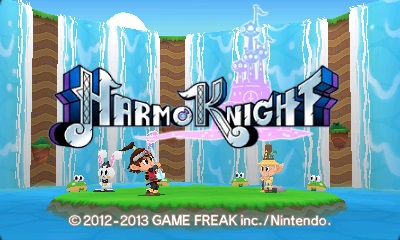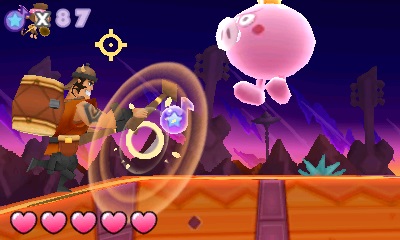

Join us as we visit a little-known title on the eShop by Pokémon developer Game Freak: HarmoKnight for the Nintendo 3DS!
Welcome to Retro Reviews, where we’ll be taking a look at games released farther back in Nintendo’s history and giving them a review here on NintenPedia. Today we have quite an oddity by the legendary developer Game Freak, a rhythm-based sidescroller of all things!
Game Freak has adopted an interest in games outside of their monster-catching franchise. Because of this, they’ve allowed many of their staff to take some of their working time pitching their own game ideas. If accepted, Game Freak may eventually develop and publish the game. HarmoKnight is the result of one of these pet projects, and it’s unlike anything we’ve ever seen from Game Freak. However, this unique little title is no less of a grand experience than the mainstream games preceding it. It’s a welcome addition to the vast list of exclusive 3DS eShop titles and stands out from the crowd. With that, let’s dive in and see if this game can hit all the right notes…because if it does, I’m going to be making a lot of additional music puns.
In contrast to the increasingly complex storylines found in the Pokémon games, HarmoKnight’s premise is clear and simple. One day in the musical world of Melodia, a string of dark green (and loud) meteorites crash down on the planet, bringing a bunch of noisy monsters with them. Enter a plucky young lad named Tempo, who’s been training with his mentor Master Woodwin and sidekick/best pal Tappy the rabbit.
Tempo aspires to become one of Melodia’s mighty warriors of old. These warriors are known as – yep, you guessed it – HarmoKnights, and according to Master Woodwin, Tempo is well on his way to becoming one. But his training is slowed to an adagio when the meteorites crash-land all over Melodia, and Tempo finds himself in the possession of a legendary staff that can be used to deflect the noise. But since Tempo supposedly isn’t quite ready to face the dangers ahead, Master Woodwin sends him to Symphony City to find someone worthy of becoming a HarmoKnight. Little does everyone know that Tempo may just be the hero Melodia needs! The story, while simple, is direct enough to keep things moving along.
Here’s where things get interesting: HarmoKnight is a sidescroller, but it’s also an auto-runner. Think Super Mario Run, mixed with the rhythmic timing of Dedede’s Drum Dash Deluxe. Tempo runs on his own through the stage from left to right, and has two moves to his name: jumping with B and swinging his staff with A. You can alternatively use the Y and X buttons, but the game never tells you this. It’s handy if one of your buttons is having an issue.
If this control scheme sounds awfully simple, that’s because it is. The real challenge is hitting everything in your way at the right time, right on the pixel in some cases. HarmoKnight has less leniency than most rhythm games and you have to time your attacks perfectly. Don’t let this deter you, however; HarmoKnight uses the power of music to get things done. You see, every enemy has a musical cue. If you use it to your advantage, you’ll hit everything on point. Since you can’t just rely on internal rhythm alone, I’d recommend you keep your volume up for this one to hear all of these cues. So why would you want to hit everything in your way? Well…
Tempo has five Hearts as his life force when he starts a stage, and he can obtain more by hitting certain items in a stage (though most stages don’t have them). If Tempo keeps more than Five Hearts at the end of a stage, those Hearts carry over into the next level he plays. In some stages, this is a lifesaver. HarmoKnight’s stages also have a certain amount of Notes to find in them, so hitting enemies and properly timing jumps all add up to your total.
Depending on how many notes you collect, you’ll be awarded a ranking of So-So, Good, or Great. If you’re a completionist, expect to be replaying a few stages multiple times, especially the boss battles, to get the best score. Completing a level with at least a Good rank earns a Royal Note and a super-fast version of the stage. Royal Notes only serve as a bar to progress, as some spots on the world map need a certain amount of Royal Notes to clear the meteorites that have fallen in your path. A few other collectibles await these stages, but I won’t spoil them here.
Apart from the main stages, there are a selection of boss battles and a few various other stages to mix things up. The boss battles are essentially follow-the-leader mini-games, where you have to repeat the actions the boss makes. While most of the battles are fun, they tend to drag out a bit, and restarting them for a perfect score means watching the cinematics over and over again. A few other special gimmicky stages only change up the formula visually, as the same buttons are used to generally do the same thing. This also goes for some sections in the main levels, where Tempo will swap out with another character to switch things up a tad. While these stages are a nice diversion from the main game, it’s still the Tempo-specific levels that really shine here.

Meet Tyko and his monkey buddy Cymbi: they’ll pop in from time to time in some stages to change up the gameplay. A few other friends await you on your journey as well.
HarmoKnight is one of those games that makes you forget that the 3DS renders games in only 240p. In other words, the game looks gorgeous. Every world has a distinct style, whether it be a beach, a clockwork tower, or a dazzling city in the nighttime. Everything in Melodia just pops out at you and makes the details of the game extremely easy to see. Good thing too, because the rhythm-based combat of HarmoKnight requires your constant attention and precise timing. All of the character models, setpieces and landscapes are well assembled. Plus the game’s framerate never drops below 60 frames per second, even on the Old 3DS. This kind of detail and silky smooth gameplay is especially appreciated in the cinematic boss battles.
These graphics change up in the cutscenes, which are few but fun to watch. These mini-movies are like 2D animated comics and contribute to the bright and colorful atmosphere the game has to offer. The same can be said for the simple world map, which is snappy to traverse and adds to the world’s theme.
The 3D (Graphics Sub-Section)
Any 3DS game that includes 3D in the mix gets an extra review section in my book. HarmoKnight’s 3D looks are on-point, and nothing is projected too far into the screen to create the mysterious “ghosting” effect found in some games. For this one, the 3D is as practical as you make it. Besides, it only adds to the fantastic visuals the game has to offer. No visual bugs to report either, since HarmoKnight runs on-rails with a locked camera.
This likely comes as a given, but I’ll say it anyway. To get the most out of this game, wear headphones. HarmoKnight is indeed a musical journey you’ll want to hear all the musical cues in the stages. Rhythm is key if you want to land all your hits since most enemies have some sort of musical cue to prep you for their attack. Usually, an enemy hints its attack 1-3 notes in advance with a sound. Thus, the key to HarmoKnight’s stages is learning to combine your attacks with the timing of these cues. This can be really difficult to do in the fast versions of stages, especially when combining attacks with jumps.
Some stages really do stand out and match up the visual theme to the musical style. The only thing with this is…HarmoKnight’s music isn’t always memorable. Most of the music relies heavily on the timing of your hits. Notes make a sound, hitting enemies makes a sound, and even jumping makes a sound. In the game’s music player, you won’t be able to hear those live sounds. The songs are still nicely composed, and you can listen to them in the Level Selection screen once you’ve cleared them.
Dedede’s Drum Dash Deluxe has a nice solution to this: Replay Jam Mode lets you watch your previous performance with all the notes you’ve hit intact. Something like this would have been a great addition to HarmoKnight.
So far I’ve talked about just about everything about HarmoKnight, but there are a few additional things to point out. First, HarmoKnight takes a musical concept and uses it to its fullest, but the game still feels pretty short. Since Game Freak only released one game like this, what you see is what you get. HarmoKnight definitely could have used a sequel, but sadly that never happened.
One of HarmoKnight’s other shortcomings is the story. If you’re looking for something really deep, you won’t for it here. Even the ending of the game just kind of drops off. Fortunately, the entire game keeps things lighthearted that a story is never especially needed.
One more heads-up: a few stages will change the tempo of a song. These challenges only happen in about 3-4 levels, so it never becomes a serious problem. The fast versions of each stage will prove to be quite a challenge too. Sometimes these extra versions can get ridiculously fast! Fortunately, they only act as a filler to extend the playtime. There’s no pressure to finish these stages, as they aren’t required to beat the game.
Overall HarmoKnight is a unique game with a great sense of rhythm. It goes out of the way to do its’ own thing among other rhythm games too. It’s not always a cakewalk, and some stages can be frustrating at first. The game also feels like it could have taken its concept a bit further and added some extra length. However, the game is only $14.99, and the content you’ll get is just enough to justify the price of admission. If you enjoy yourself some toe-tapping, color-filled gameplay, then pick this up some time on the eShop. You’ll be amazed at the musical fun that HarmoKnight has to offer. Oh, and make some music puns while you’re at it.
Final Score: 9/10.